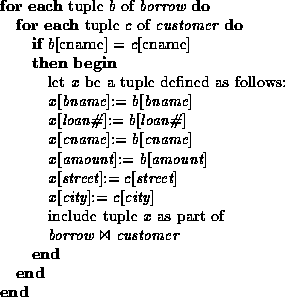Buffer Management



Next:
Up: File & System
Previous: Data Dictionary Storage
-
- We need to use disk storage for the database, and to transfer blocks of
data between MM and disk.
- We also want to minimize the number of such transfers, as they are
time-consuming.
- One way is to keep as many blocks as possible in MM.
- Usually, we cannot keep all blocks in MM, so we need to manage the
allocation of available MM space.
- The buffer is the part of MM available for storage of copies
of disk blocks.
- The subsystem responsible for the allocation of buffer space is called
the buffer manager.
- The buffer manager handles all requests for blocks of the database.
- If the block is already in MM, the address in MM is given to the
requestor.
- If not, the buffer manager must read the block in from disk (possibly
displacing some other block if the buffer is full) and then pass the address
in MM to the requestor.
-
The buffer manager must use some sophisticated techniques in order to provide
good service:
- Replacement Strategy - When there is no room left in the buffer,
some block must be removed to make way for the new one.
Typical operating system memory management schemes use a ``least recently
used'' (LRU) method.
(Simply remove the block least recently referenced.)
This can be improved upon for database applications.
- Pinned Blocks - For the database to be able to recover from
crashes, we need to restrict times when a block maybe written back to disk.
A block not allowed to be written is said to be pinned.
Many operating systems do not provide support for pinned blocks, and such a
feature is essential if a database is to be ``crash resistant''.
- Forced Output of Blocks - Sometimes it is necessary to write a
block back to disk even though its buffer space is not needed.
(Called the forced output of a block.)
This is due to the fact that MM contents (and thus the buffer) are lost in a
crash, while disk data usually survives.
-
Replacement Strategy:
Goal is minimization of accesses to disk.
Generally it is hard to predict which blocks will be referenced.
So operating systems use the history of past references as a guide
to prediction.
- General Assumption: Blocks referenced recently are likely to
be used again.
- Therefore: if we need space, throw out the least recently
referenced block.
(LRU replacement scheme)
-
LRU is acceptable in operating systems, however, a database system
is able to predict future references more accurately.
-
Consider processing of the relational algebra expression

-
Further, assume the strategy to process this request is given by the
following pseudo-code:

-
Assume that the two relations in this example are stored in different files.
- Once a tuple of borrow has been processed it is not needed again.
- Therefore, once processing of an entire block of tuples is finished,
that block is not needed in MM.
- Note that this block has been used very recently.
- Buffer manager should free the space occupied by a borrow block as soon
as it is processed.
- This strategy is called toss-immediate.
- Consider blocks containing customer tuples.
- Every block of customer tuples must be examined once for every
tuple of the borrow relation.
- When processing of a customer block is completed, it will not be
used again until all other customer blocks have been processed.
- This means the most recently used (MRU) block will be the last block
to be re-referenced, and the least recently used will be referenced next.
- This is the opposite of LRU assumptions.
- So for inner block, use MRU strategy - if a customer block must be
removed from the buffer, choose MRU block.
- For MRU strategy, the system must pin the customer
block currently being processed until the last tuple has been processed.
- Then it may be unpinned, becoming the most recently used block.
-
The buffer manager may also use statistical information regarding the
probability that a request will reference a particular relation.
- The data dictionary is the most frequently-used part of the database.
- It should, therefore, not be removed from MM unless necessary.
- File indices (Chapter 8) are also frequently used, and should generally
be in MM.
- No single strategy is known that handles all possible scenarios well.
- Many database systems use LRU, with all its faults.
- Other factors enter with concurrent users, where requests may be
delayed to ensure integrity of the database.



Next:
Up: File & System
Previous: Data Dictionary Storage
Page created and maintained by Osmar R. Zaï ane
Last Update:
Tue Oct 31 12:59:25 PST 1995




